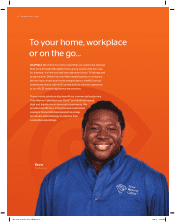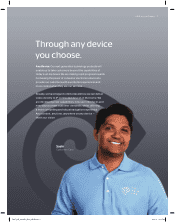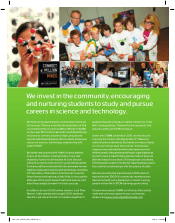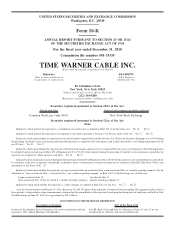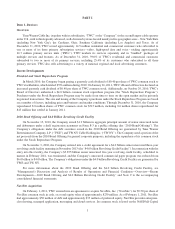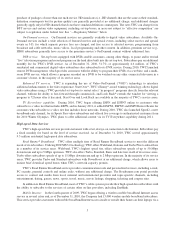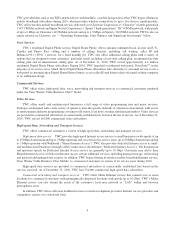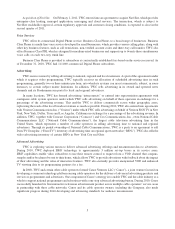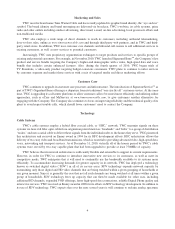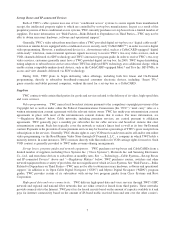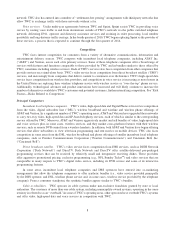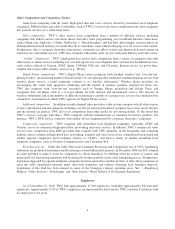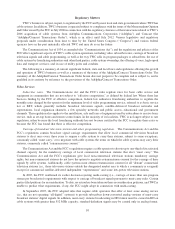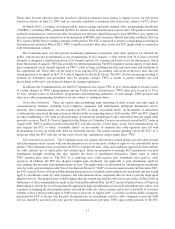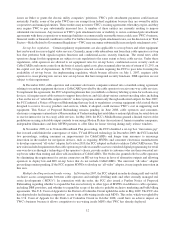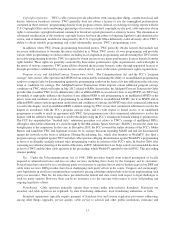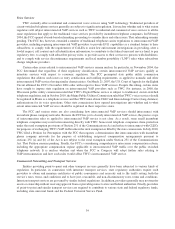Time Warner Cable 2010 Annual Report Download - page 18
Download and view the complete annual report
Please find page 18 of the 2010 Time Warner Cable annual report below. You can navigate through the pages in the report by either clicking on the pages listed below, or by using the keyword search tool below to find specific information within the annual report.Marketing and Sales
TWC uses the brand name Time Warner Cable and has recently updated its graphic brand identity, the “eye and ear”
symbol. The brand identity and brand messaging are delivered via broadcast, TWC’s website, its cable systems, print,
radio and other outlets including outdoor advertising, direct mail, e-mail, on-line advertising, local grassroots efforts and
non-traditional media.
TWC also employs a wide range of direct channels to reach its customers, including outbound telemarketing,
door-to-door sales, online at www.timewarnercable.com and through third-party web partners, and in TWC and third-
party retail stores. In addition, TWC uses customer care channels and inbound call centers to sell additional services to
existing customers, as well as new services to potential customers.
Increasingly, TWC uses proprietary segmentation techniques to target products and services to specific groups of
existing and potential customers. For example, in November 2010, TWC launched SignatureHome
TM
, the Company’s first
product and service bundle targeting the Company’s higher-end demographic with a video, high-speed data and voice
bundle that includes certain enhanced features. Also, during the fourth quarter of 2010, TWC began trials of
TV Essentials, a video-only product targeting budget-conscious consumers. TWC plans to continue to tailor services
by customer segment and market these services with a mix of targeted media and direct marketing efforts.
Customer Care
TWC continues to upgrade its customer care processes and infrastructure. The introduction of SignatureService
TM
as
part of TWC’s SignatureHome offering is a departure from its traditional “one size fits all” customer service. At the same
time, TWC is upgrading its call center platforms to allow customer calls to be routed more efficiently and utilizing online
approaches, such as eCare and MyService at www.timewarnercable.com, to give customers another alternative for
engaging with the Company. The Company also continues to focus on improving reliability and the technical quality of its
plant to avoid repeat trouble calls, which should lower customers’ need to contact the Company.
Technology
Cable Systems
TWC’s cable systems employ a hybrid fiber coaxial cable, or “HFC,” network. TWC transmits signals on these
systems via laser-fed fiber optic cable from origination points known as “headends” and “hubs” to a group of distribution
“nodes,” and uses coaxial cable to deliver these signals from the individual nodes to the homes they serve. TWC pioneered
this architecture and received an Emmy award in 1994 for its HFC development efforts. HFC architecture allows the
delivery of two-way video and broadband transmissions, which is essential to providing advanced video, high-speed data,
voice, networking and transport services. As of December 31, 2010, virtually all of the homes passed by TWC’s cable
systems were served by two-way capable plant that had been upgraded to provide at least 750MHz of capacity.
TWC believes that its network architecture is sufficiently flexible and extensible to support its current requirements.
However, in order for TWC to continue to introduce innovative new services to its customers, as well as meet its
competitive needs, TWC anticipates that it will need to continually use the bandwidth available to its systems more
efficiently. To accommodate increasing demands for greater capacity in its network, TWC has deployed a technology
known as switched digital video (“SDV”) in all of its service areas. SDV technology expands network capacity by
transmitting only those digital and HD video channels that are being watched within a given grouping of households at
any given moment. Since it is generally the case that not all such channels are being watched at all times within a given
group of households, SDV technology frees up capacity that can then be made available for other uses, including
additional HD channels, expanded VOD offerings, faster high-speed data connections, reliable Digital Phone quality and
interactive services. TWC received an Emmy award in 2008 for its efforts in SDV technology development. In addition to
its use of SDV technology, TWC expects that over the next several years it will continue to reclaim analog spectrum.
6


